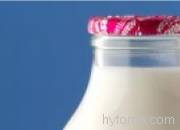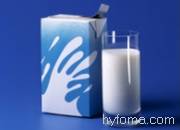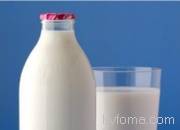 download article
download articleMilk
Article index
 | Means of processing: From automated milking to the dairy | |
 | Step by step: From raw milk to filling | |
 | Hygiene regulations prevent health problems |
Means of processing: From automated milking to the dairy
The same process is carried out in automatic units. However, automatic units can also be used to measure and document the attained milk quantity and other interesting milking data from every cow. The milk can be automatically separated. Automatic milking units normally contain intermediate storage tanks and an automatic cleaning system.Large modern dairies were often created from cooperatives in which the dairy farmers are the partners who supply the milk. The milk is transported to the dairy once per two or three days. The milk collection tanker (MCT) is often equipped with an air separator and a volume flow meter. The conductance of milk ranges between 3.5 and 5.0 mS/cm. The natural air content is around 6%. It may amount to up to 10% after transportation. This not only has an effect on flow measurements, but also on the pasteurizer and separator functions. Efficient degassing is essential when taking delivery of milk. Vacuum degassing systems are used in this respect.
The taste and odor of the milk are evaluated at the time of delivery. A bacteriological test is also carried out, the number of cells and germs are determined, and the fat and protein content are measured. A freezing point test can be performed to determine whether water has been added to milk. Accounting and settlement are based on the weight and fat content of the milk.
Step by step: From raw milk to filling
The raw milk is stored temporarily at a cool temperature. If it is to be used as drinking milk, the fat content is first adjusted. Separators are used for this purpose. The fat content is reduced to a value of 0.05% and is then automatically regulated by means of 3 flow meters and set with the extracted cream to the required value. The milk is often preheated during this step to a temperature of between 55°C and 65°C. The excess cream is reused and the cream fat content is calculated using a densitometer.Milk can be homogenized in order to ensure that the fat particles are of the same size and are constantly distributed. Homogenization is carried out at high pressure using a defined valve. Homogenization reduces the tendency towards cream formation. The color and aroma of the milk are improved and the product becomes more stable.
In order to preserve the milk, it is subjected to thermal treatment. This generally involves short-time heating to a temperature of between 72°C and 75°C for 30 to 32 seconds. However, the treatment time can also be shortened by using higher temperatures. This UHT process functions at temperatures above 135°C and with process times of a few seconds. Heat treatment of milk must be measured by means of approved instruments and documented according to the Milk Heating Ordinance.
The milk is then filled in bottles (glass or PET), cartons or skins.
Hygiene regulations prevent health problems
The milk industry must closely observe international hygiene regulations as pathogenic germs which cause health problems can also grow in milk. The regulations and standards of 3-A and EHEDG are frequently used internationally.Click for additional information about Milk
 back to top
back to top






 companies
companies



